
Dysphania botrys, the Jerusalem oak goosefoot, sticky goosefoot or feathered geranium, is a flowering plant in the genus Dysphania. It is native to the Mediterranean region.
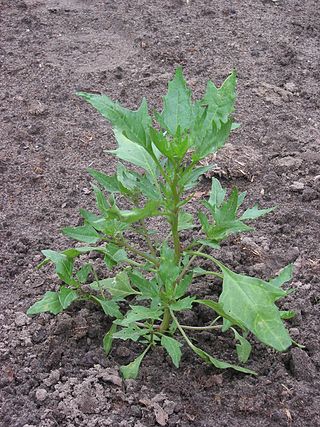
Oxybasis rubra, common names red goosefoot or coastblite goosefoot, is a member of the genus Oxybasis, a segregate of Chenopodium. It is native to North America and Eurasia. It is an annual plant.

Ambrosia acanthicarpa is a North American species of bristly annual plants in the family Asteraceae. Members of the genus Ambrosia are called ragweeds. The species has common names including flatspine bur ragweed, Hooker's bur-ragweed, annual burrweed, annual bur-sage, and western sand-bur. The plant is common across much of the western United States and in the Prairie Provinces of Canada.

Chenopodiastrum murale, is a species of plant in the family Amaranthaceae known by the common names nettle-leaved goosefoot, Australian-spinach, salt-green, and sowbane. This plant is native to Europe and parts of Asia and northern Africa, but it is widespread worldwide, particularly in tropical and subtropical areas due to the ease of it being introduced. It is a common weed of fields and roadsides.

Blitum californicum is a species of flowering plant in the amaranth family known by the common names California goosefoot and (ambiguously) "Indian lettuce".
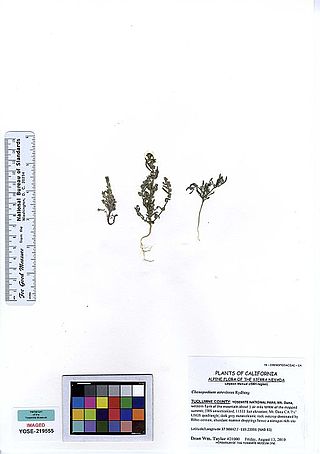
Chenopodium atrovirens is a species of flowering plant in the amaranth family known by the common names pinyon goosefoot and dark goosefoot.
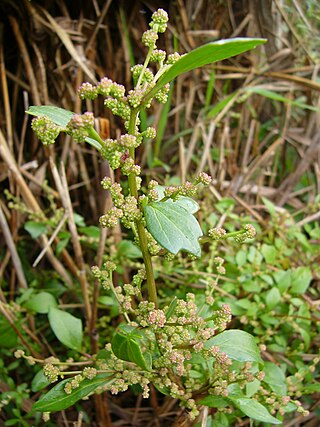
Oxybasis chenopodioides, is a species of flowering plant in the family Amaranthaceae known by the common name low goosefoot.

Chenopodium fremontii is a species of flowering plant in the family Amaranthaceae known by the common name Frémont's goosefoot. Both the species' specific epithet, and the common name derive from the 19th century western pioneer John C. Frémont.
Chenopodium hians is a species of flowering plant in the family Amaranthaceae known by the common names hians goosefoot and gaping goosefoot. The Latin species name hians means "gaping".
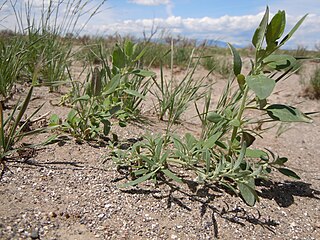
Chenopodium leptophyllum is a species of flowering plant in the family Amaranthaceae known by the common name narrowleaf goosefoot.

Dysphania multifida is a species of flowering plant in the family Amaranthaceae known by the common names cutleaf goosefoot and scented gooosefoot.

Chenopodium pratericola is a species of flowering plant in the goosefoot family known by the common name desert goosefoot. It is native to much of western and central North America, where it grows in many types of open habitat, such as sagebrush, often on alkaline soils.
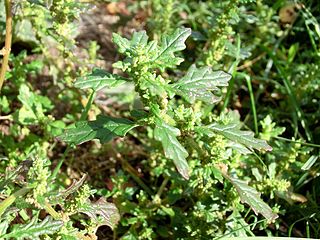
Dysphania pumilio is a species of flowering plant in the family Chenopodioideae known by the common name clammy goosefoot.

Madia sativa, known by the common names coast tarweed and Chilean tarweed, is a species of flowering plant in the family Asteraceae found in parts of western North and South America.

Mentzelia albicaulis is a species of flowering plants in the family Loasaceae known by the common names whitestem blazingstar, white-stemmed stickleaf, and small flowered blazing star. It is native to much of western North America, where it grows in mountain, desert, and plateau habitat.

Blitum nuttallianum, is a species of flowering plant in the amaranth family known by the common names povertyweed and Nuttall's povertyweed. It is native to North America, where it is widespread and common from Alaska to Mexico to New England. It can be found in many types of habitat, including disturbed areas, often favoring wet places. It is a fleshy annual herb producing two or more erect, reddish, hairless stems up to about 40 centimeters tall. The thick lance-shaped or arrowhead-shaped leaves are up to 4 centimeters in length. Clusters of several rounded flowers each appear in the leaf axils and yield small fruits about 2 millimeters wide.

Montia parvifolia is a species of flowering plant in the family Montiaceae known by the common names little-leaf miner's lettuce, small-leaved blinks and small-leaved montia. It is native to western North America from Alaska to California to Montana, where it grows in moist to wet areas in several types of mountain habitat.

Senecio sylvaticus is a species of flowering plant in the aster family. It is variously known as the woodland ragwort, heath groundsel, or mountain common groundsel. It is native to Eurasia, and it can be found in other places, including western and eastern sections of North America, as an introduced species and an occasional roadside weed. It grows best in cool, wet areas. It is an annual herb producing a single erect stem up to 80 centimeters tall from a taproot. It is coated in short, curly hairs. The toothed, deeply lobed leaves are up to 12 centimeters long and borne on petioles. They are evenly distributed along the stem. The inflorescence is a wide, spreading array of many flower heads, each lined with green- or black-tipped phyllaries. The heads contain yellow disc florets and most have very tiny yellow ray florets as well.
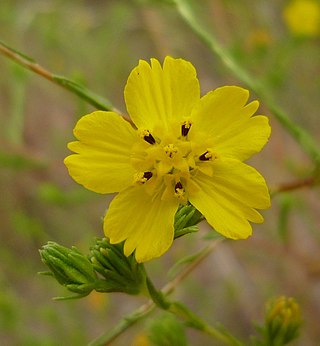
Deinandra fasciculata, known by the common names clustered tarweed and fascicled spikeweed, is a species of flowering plant in the family Asteraceae native to western North America.

Hedypnois rhagadioloides, the Cretanweed or scaly hawkbit, is a species of plant in the tribe Cichorieae within the family Asteraceae. It is native to the Mediterranean Region and neighboring areas from Canary Islands to Iran, and naturalized in Australia and in parts of the Americas.




















